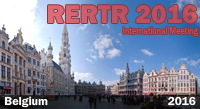Abstracts and Available Papers Presented at the
2002 International RERTR Meeting
HYDRAULIC AND HYDRODYNAMIC TESTS FOR DESIGN EVALUATION OF RESEARCH REACTORS FUEL ELEMENTS
Kulichevsky, R.; MartínGhiselli, A.; Fiori, J.; Yedros, P.
Non Destructive and
Structural Testing Branch, Comisión Nacional de Energía Atómica (CNEA)
Av. Gral. Paz 1499 (1650), San Martín, Buenos Aires, Argentina.
Tel/Fax: +54-11-6772-7426
E-mail: [email protected]; [email protected]
ABSTRACT
During the design steps of research reactors fuel elements some tests are usually necessary to verify its design, i.e.: its hydraulic characteristics, dynamical response and structural integrity.
The hydraulic tests are developed in order to know the pressure drops characteristics of different parts or elements of the prototype and of the whole fuel element. Also, some tests are carried out to obtain the velocity distribution of the coolant water across different prototype’s sections.
The hydrodynamic tests scopes are the assessment of the dynamical characteristics of the fuel elements and their components and its dynamical response considering the forces generated by the coolant flowing water at different flow rate conditions.
Endurance tests are also necessary to qualify the structural design of the FE prototypes and their corresponding clamp tools, verifying the whole system structural integrity and wear processes influences.
To carry out these tests a special test facility is needed to obtain a proper representation of the hydraulic and geometric boundary conditions of the fuel element. In some cases changes on the fuel element prototype or dummy are necessary to assure that the data results are representative of the case under study.
Different kind of sensors are mounted on the test section and also on the fuel element itself when necessary. Some examples of the instrumentation used are strain gauges, displacement transducers, absolute and differential pressure transducers, pitot tubes, etc. The obtained data are, for example, plates´ vibration amplitudes and frequencies, whole bundle displacement characterization, pressure drops and flow velocity measurements.
The Experimental Low Pressure Loop is a hydraulic loop located at CNEA´s Constituyentes Atomic Center and is the test facility where different kind of tests are performed in order to support and evaluate the design of research reactor fuel elements.
A brief description of the facility, and examples of the tests performed and results obtained are presented in this paper.
![]() PDF version available
PDF version available
DOWNLOAD full paper in PDF format.
Contact:
Mr. Raúl Kulichevsky
Engineer
CNEA-CAC, EECE-ENDE
Avda. del Libertador
8250
C1429BNO Buenos Aires, Argentina
Phone: (54 11) 6772
7438
Fax: (54 11) 6772
7426
E-mail: [email protected]




